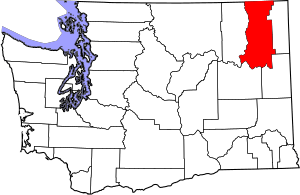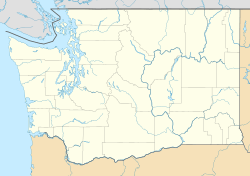Bossburg, Washington facts for kids
Quick facts for kids
Bossburg, Washington
|
|
|---|---|
 |
|
| Country | United States |
| State | Washington |
| County | Stevens |
| Population
(1892)
|
|
| • Total | 800 |
| Time zone | UTC-8 (Pacific (PST)) |
| • Summer (DST) | UTC-7 (PDT) |
Bossburg is a ghost town located in Stevens County, Washington. It sits on the east side of the Columbia River, very close to the Canada–US border. In 1892, Bossburg was a busy place with about 800 people living there.
The town was first called "Young America." But in 1896, it was renamed Bossburg to honor C. S. Boss, who was one of its first citizens. Today, Bossburg is most famous for something mysterious that happened in 1969. People found large, human-like footprints in the snow. These tracks were believed to be from a Sasquatch (also known as Bigfoot) with a unique, crippled foot, which led to the name "Cripplefoot."
Contents
History of Bossburg
Bossburg started as a mining town. People dug for valuable metals like lead and silver. When the mines began to produce less, the town faced money problems. To try and keep Bossburg going, a ferry was set up to cross the Columbia River. A sawmill was also built to process lumber.
Bossburg even had its own newspapers. The Bossburg Journal was published for many years, and the Bossburg Herald came out for a short time. The town's cemetery is still used today. Local families take care of it, but some graves do not have names on them.
The Bossburg Cripplefoot Mystery
Bossburg became famous for a strange discovery related to Bigfoot.
Finding the Cripplefoot Tracks
On November 24, 1969, something amazing happened near the old Bossburg town dump. People found very large, human-like tracks in the snow. What made these tracks special was that the right foot seemed to be crippled. Earlier that year, a woman had reported seeing a Sasquatch nearby.
Many believed these tracks were made by an injured Bigfoot. Locals started calling the creature the "Bossburg Cripple." Today, it is usually known as "Cripplefoot." A Bigfoot researcher named René Dahinden came to investigate on November 27. However, many curious people had already walked over the tracks. Dahinden managed to photograph and make a plaster cast of the best print he could find. Another researcher, Bob Titmus, joined him for a few days.
After searching for two weeks, Ivan Marx, a Bossburg resident, and René Dahinden found more evidence. On December 13, 1969, they discovered 1089 giant human-like tracks in the snow. These tracks led to, from, and across a river near Lake Roosevelt. An anthropologist named Grover Krantz joined them. He took photos and made casts of the tracks. Later, filmmaker Roger Patterson and his assistant, Dennis Jenson, also spent time there. Scientists like primatologist John Napier and anthropologist Jeff Meldrum studied the casts and photos. They became convinced that the tracks were real.
René Dahinden was also impressed by the tracks. But he had some doubts about how they were found. For example, Ivan Marx stopped their car, walked off, and then returned saying he had found tracks. This happened right after they passed an empty Jeep. René wondered if the Jeep's owners might have been making the tracks. The Jeep was gone when they returned. Still, René eventually believed the tracks were authentic.
Sasquatch Hoaxes and Tricks
Not everything about the Bossburg Bigfoot story was real. Some people tried to trick the researchers.
The Captured Sasquatch Story
In January 1970, while Bigfoot researchers were in Bossburg, a prospector named Joe Metlow approached them. He claimed he had a Bigfoot trapped in an old mine shaft. He said he had already sold it. The researchers offered to pay more, starting a bidding war. John Green, a Canadian Sasquatch researcher, also got involved. Metlow refused to let anyone see the Bigfoot, even for a lot of money. The bids went up to $55,000, but Metlow wouldn't show proof. People soon realized he was bluffing, and interest faded.
The Sasquatch Foot in a Freezer Story
Joe Metlow then claimed he had a Sasquatch foot stored in his freezer. This started another bidding war. Again, he avoided showing the foot and kept changing his story. He even backed out of a trip where buyers could view it. At this point, the Bigfoot researchers realized they had been tricked again.
The Filmed Sasquatch Hoax
Nine months later, in October 1970, Ivan Marx called René Dahinden. He said, "I've got a film of the cripple[foot Bigfoot]." Bigfoot researchers rushed back to Bossburg. After watching the film, most were convinced it was real. Another bidding war began for the film's rights.
However, researcher Peter Byrne listened to some children who said they knew where the film was shot. When he visited the location, he found that the area did not match what Marx had claimed about the filming. Further investigation revealed more problems with the story. Soon, belief in the film disappeared. Peter Byrne and Michael McLeod both wrote detailed accounts of this trick.



